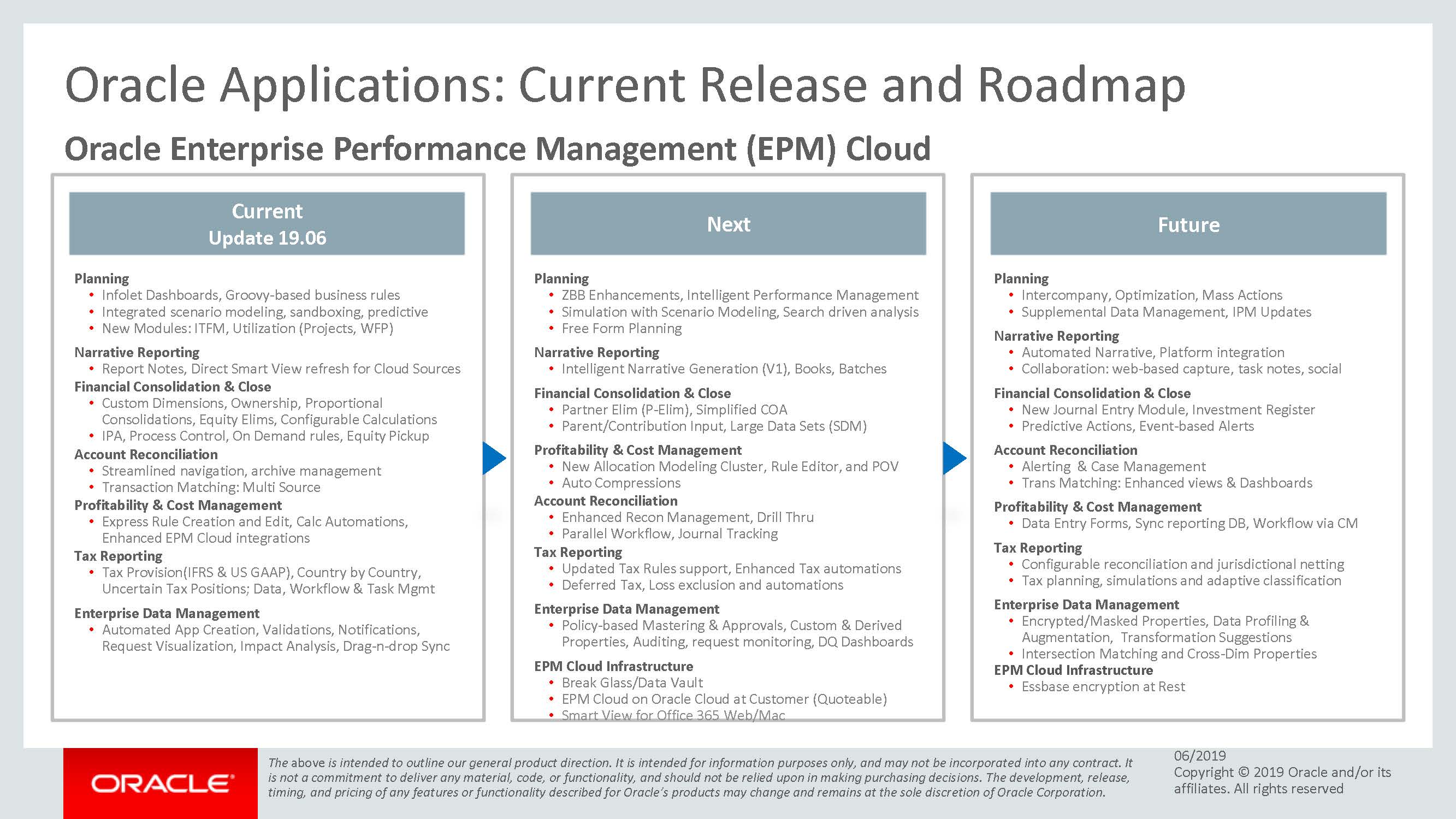Oracle has made a lot of changes to both their EPM and Analytics solutions, making the updates difficult to keep up with as well as causing confusion. This blog post will help clarify the new direction of the Oracle EPM Cloud as well as what to expect with future updates.
Below you’ll find information on…
- Changes to product names and pricing plan
- How the changes affect current customers
- Terminology changes
- The EPM Cloud Roadmap
Author's Note: Any updates to features, functionality, or timing mentioned in this blog post are subject to change at the sole discretion of Oracle.

New Product Names & Pricing Plan
June and the arrival of Kscope19 brought about the announcement of many updates to the Oracle EPM Cloud, one of the most significant being the structure of the Cloud and its corresponding pricing plan.
If you go to the Oracle EPM webpage, you’ll notice a couple of things. The most significant being that the name has changed — you don’t see PBCS, EPBCS, ARCS, FCCS, etc. listed anymore.
Instead, you’ll see…
- Account Reconciliation
- Enterprise Data Management
- Financial Consolidation and Close
- Narrative Reporting
- Planning
- Profitability and Cost Management
- Tax Reporting
At first glance, that doesn’t seem like a huge change since the names are representative what each tool can do. However, if you go over to the pricing page, you now only see two options…
- Enterprise Performance Management Standard Cloud
- Enterprise Performance Management Enterprise Cloud
There are no longer separate cloud services for your EPM solutions — the solutions you’re used to will now be available in one of the two above EPM Cloud Services, in an all-encompassing package.
Below are the details of what’s included with each new cloud service as well as the pricing.
EPM Standard Cloud
$250/user per month
This cloud service includes…
- Module-based Planning
- Capital
- Financials
- Projects
- Workforce
- Scenario (Strategic) Modeling
- 5 seeded hybrid BSO cubes and 1 seeded ASO cube for module use only
- 1 free (unseeded) hybrid BSO cube and 1 free (unseeded) ASO cube
- All BSO cubes deployed in hybrid mode
- Max of 8 cubes
- Account Reconciliation
- Financial Consolidation and Close (with default, built-in calculations)
- Transaction Matching
- Custom Consolidations
- Intelligence Process Automation
- Intelligence Performance Management
- Narrative Reporting
- Disclosure Management
On the Planning side, this cloud service excludes…
- Custom Planning
- Free Form Planning
- Customized Groovy script
- Intelligent Process Automation
- Intelligent Process Automation
- Intelligent Performance Management
EPM Enterprise Cloud
$500/user per month; or
Hosted Employee pricing: $40/employee per month
Note that the hosted employee pricing is available to organizations with a minimum of 5,000 employees and includes access to advanced customization and features.
This cloud service includes…
Planning Business Process
- Business Process Types
- Custom
- Module-based (Financial, Workforce, Capital, Projects)
- Free Form
- Scenario (Strategic) Modeling
- Hybrid BSO cubes and ASO Reporting Cubes
- Groovy support for customizing business rules
- Cube layout for Business Process types
- Custom: 6 Hybrid BSO; 6 ASO
- Module-based:
- Seeded Module Cubes: up to 5 Hybrid BSO; 1 ASO
- Free cubes: up to 3 Hybrid BSO cubes; 4 ASO cubes
- Max up to 13 cubes
- Free-form
- 1 cube (choice of Hybrid BSO or ASO) per application
- Mulit-cube per application (in 2019 roadmap)
Account Reconciliation
- Includes Transaction Matching
Financial Consolidation and Close
- Default and Custom Consolidation Calculations
- Support for Complex Structures
- Integration of Close Manager with other Oracle Products
Narrative Reporting
- Includes Disclosure Management
Enterprise Data Management (with maximum 5000 hosted records)
Profitability and Cost Management
Tax Reporting
How new Pricing & Structure Affects Current EPM Cloud Customers
If you’re a current subscriber to any of the old cloud services (PBCS, EPBCS, FCCS, TRCS, ARCS, PCMCS), it will still work as it does now. The existing features and future functionality will continue to be available to you and "work seamlessly," according to Oracle.
The only change you’ll experience in your user experience is that the Connections Manager interface will show new screens for all customers. There will be no impact on SWP and Sales Planning/Forecasting apps, except for the new landing page.
As far as pricing goes, you still have the option to renew using old SKU’s, and you can add new users to your existing subscription using the old pricing model. However, any new subscriptions should use the new pricing.
Current customers can also move to the new model before renewal or at their renewal date.
If you have any questions about pricing or switching to the new model, we can help. Contact us here.
Terminology Changes
Below is a quick breakdown of terminology changes to help you avoid confusion…
Old Terminology vs. New Terminology
Application > Business Process
Planning and Budgeting Cloud > Planning
Enterprise Planning and Budgeting Cloud business processes (such as Workforce) > Planning Modules
Enterprise Performance Reporting Cloud > Narrative Reporting
Oracle EPM Cloud Roadmap
Below you’ll see an updated version of the Oracle EPM Cloud roadmap. You should also note that there are a lot of new and innovative features coming to the Oracle EPM Cloud. Follow our blog for future updates and details on new features.







